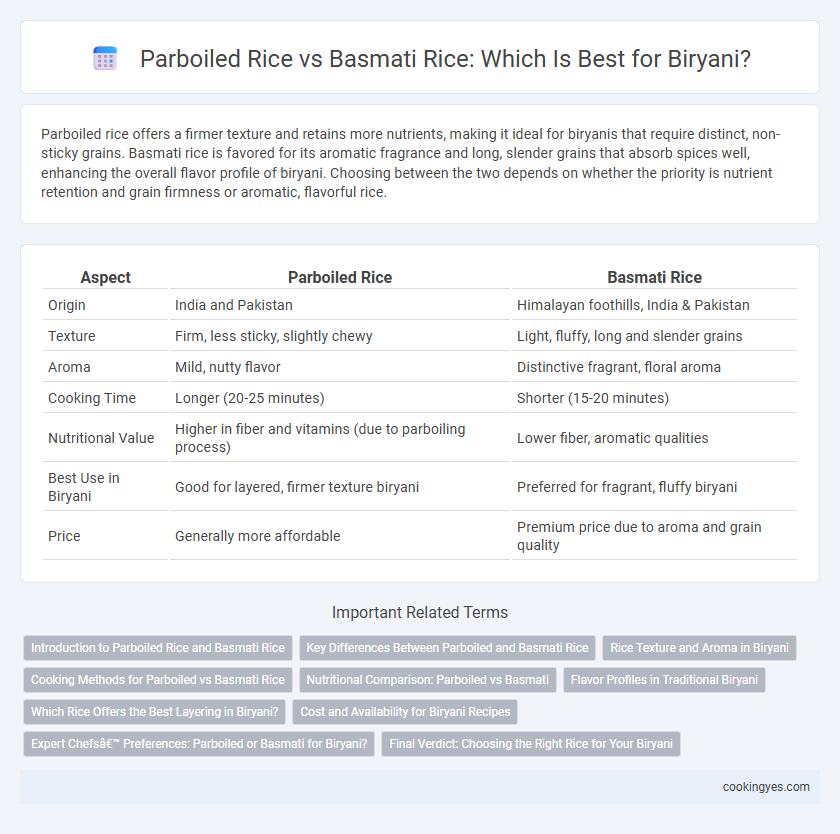Parboiled rice offers a firmer texture and retains more nutrients, making it ideal for biryanis that require distinct, non-sticky grains. Basmati rice is favored for its aromatic fragrance and long, slender grains that absorb spices well, enhancing the overall flavor profile of biryani. Choosing between the two depends on whether the priority is nutrient retention and grain firmness or aromatic, flavorful rice.
Table of Comparison
| Aspect | Parboiled Rice | Basmati Rice |
|---|---|---|
| Origin | India and Pakistan | Himalayan foothills, India & Pakistan |
| Texture | Firm, less sticky, slightly chewy | Light, fluffy, long and slender grains |
| Aroma | Mild, nutty flavor | Distinctive fragrant, floral aroma |
| Cooking Time | Longer (20-25 minutes) | Shorter (15-20 minutes) |
| Nutritional Value | Higher in fiber and vitamins (due to parboiling process) | Lower fiber, aromatic qualities |
| Best Use in Biryani | Good for layered, firmer texture biryani | Preferred for fragrant, fluffy biryani |
| Price | Generally more affordable | Premium price due to aroma and grain quality |
Introduction to Parboiled Rice and Basmati Rice
Parboiled rice undergoes partial boiling in the husk, enhancing its nutritional value and producing firmer, less sticky grains ideal for biryani. Basmati rice, known for its aromatic fragrance and long, slender grains, offers a light texture that absorbs spices beautifully, making it a traditional choice in biryani preparation. Comparing these, parboiled rice provides durability and texture, while basmati delivers distinctive aroma and softness essential for authentic biryani flavors.
Key Differences Between Parboiled and Basmati Rice
Parboiled rice has a firmer texture and retains more nutrients due to its steaming process, making it less sticky and ideal for absorbing spices in biryani. Basmati rice offers long, slender grains with a distinctive aroma and delicate fluffiness, enhancing the traditional biryani flavor profile. Key differences lie in cooking time, grain texture, and aroma, with parboiled rice favored for moisture retention and basmati for its aromatic quality.
Rice Texture and Aroma in Biryani
Parboiled rice offers a firmer, less sticky texture that holds its shape well in biryani, making it ideal for layered dishes. Basmati rice, known for its long grains and delicate, fragrant aroma, imparts a distinctive scent that enhances the overall flavor profile of biryani. The choice between the two depends on whether a more robust texture or an aromatic, fragrant experience is preferred in the final dish.
Cooking Methods for Parboiled vs Basmati Rice
Parboiled rice requires prolonged soaking and a distinct boiling process to achieve its firm texture, which prevents the grains from clumping during biryani preparation. Basmati rice demands precise rinsing and a shorter cooking time to maintain its long, aromatic grains and fluffy consistency essential for traditional biryani. The differing water absorption rates and cooking durations significantly influence the final texture and flavor profile in biryani dishes.
Nutritional Comparison: Parboiled vs Basmati
Parboiled rice contains higher amounts of retained vitamins and minerals such as thiamine, iron, and magnesium compared to basmati rice due to its unique soaking and steaming process. Basmati rice has a lower glycemic index and contains more fiber, promoting better blood sugar control and digestion. Both types offer distinct nutritional benefits, making them suitable for different dietary needs within biryani preparations.
Flavor Profiles in Traditional Biryani
Parboiled rice offers a nutty aroma and firm texture that absorbs spices well, making it ideal for layered biryanis like Hyderabadi-style. Basmati rice features a delicate floral fragrance and slender grains that provide a fluffy, separate grain texture, enhancing the biryani's aromatic complexity. The choice between parboiled and basmati rice significantly influences the traditional biryani flavor profile, balancing robustness with elegance.
Which Rice Offers the Best Layering in Biryani?
Parboiled rice is favored for biryani layering due to its firm texture and ability to remain separate during slow cooking, preventing clumping and ensuring each grain is distinct. Basmati rice offers long, slender grains with a delicate aroma that enhances the biryani's sensory appeal but requires careful handling to avoid stickiness. For optimal layering, parboiled rice provides structural integrity, while basmati rice delivers aromatic elegance, with many chefs combining both varieties to balance texture and fragrance.
Cost and Availability for Biryani Recipes
Parboiled rice is more affordable and widely available compared to Basmati rice, making it a cost-effective choice for biryani recipes on a budget. Basmati rice, known for its aromatic fragrance and long grains, tends to be pricier and less accessible in some regions, potentially increasing the overall cost of biryani preparation. Choosing parboiled rice ensures consistent texture and easier procurement, while Basmati rice offers superior flavor and authenticity but at a higher price point.
Expert Chefs’ Preferences: Parboiled or Basmati for Biryani?
Expert chefs often prefer Basmati rice for biryani due to its long grains, aromatic fragrance, and fluffy texture that absorbs spices well, creating a distinct and layered flavor profile. Parboiled rice is favored in some regional biryani recipes for its firmer grains and resistance to overcooking, which helps maintain the dish's integrity during slow cooking. The choice between parboiled and Basmati rice ultimately depends on the desired texture and regional style of the biryani being prepared.
Final Verdict: Choosing the Right Rice for Your Biryani
Parboiled rice offers a firmer texture and retains more nutrients, making it ideal for biryanis that require distinct, separate grains with a slightly chewy bite. Basmati rice, known for its aromatic fragrance and slender, long grains, delivers a fluffy and flavorful biryani experience with each grain remaining light and non-sticky. For an authentic, aromatic biryani with a delicate texture, basmati rice is typically preferred, while parboiled rice suits recipes demanding robust grains and enhanced nutritional value.
Parboiled rice vs Basmati rice for biryani Infographic

 cookingyes.com
cookingyes.com